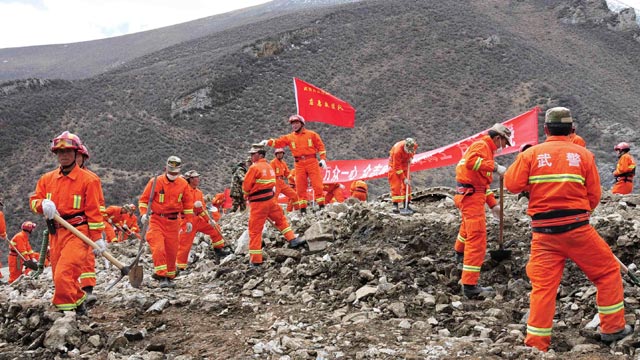
Authorities in Tibet said Sunday that chances were slim that any survivors would be found after a massive mudslide at a gold mine buried 83 workers in piles of earth up to 30 meters deep. Searchers have found 11 bodies and were searching for the remaining missing.
The landslide Friday has spotlighted the extensive mining activities in the mountainous Chinese region of Tibet and sparked questions about whether mining activities have been excessive and destroyed the region’s fragile ecosystem.
The workers were buried when mud, rock and debris swept through the mine in Gyama village in Maizhokunggar county and covered an area measuring around 4 square kilometers (1.5 square miles), about 70 kilometers (45 miles) east of the regional capital, Lhasa.
By Sunday afternoon, searchers had found 11 bodies and were searching for the remaining 72 missing workers, the state-run Xinhua News Agency said. Xinhua quoted the Communist Party deputy secretary for Tibet, W. Yingjie, as saying chances were slim of finding anyone alive.
The miners worked for Huatailong Mining Development, a subsidiary of the China National Gold Group Corp., a state-owned enterprise and the country’s largest gold producer. Beijing says the cause of the disaster has yet to be fully investigated, although state media say the mudslide was caused by a “natural disaster,” without giving specifics.
Criticisms over possibly excessive mining in Tibet flashed through China’s social media Saturday before they were scrubbed off or blocked from public view by censors.
Btan Tundop, a Tibetan resident, noted the Huatailong mine’s dominance in the area in a short-lived microblog: “The entire Maizhokunggar has been taken over by China National Gold Group. Local Tibetans say the county and the village might as well be called Huatailong.”
The Chinese government has been encouraging development of mining and other industries in long-isolated Tibet as a way to promote its economic growth and raise living standards. The region has abundant deposits of copper, chromium, bauxite and other precious minerals and metals, and is one of fast-growing China’s last frontiers.
Tibet remains among China’s poorest regions despite producing a large share of its minerals. A key source of anti-Chinese anger is complaints by local residents that they get little of the wealth extracted by government companies, most of which flows to distant Beijing.
Wangchuktseten, a Tibetan scholar at Northwest University of Nationalities in Lanzhou, the capital of Gansu province, said he was most worried about the environment. “The Tibetan plateau is considered the lungs of Asia,” he said. “Those short-sighted mining activities chase after quick benefits but ignore the environment for future generations.”
State media said that two of the buried workers are Tibetans, and that two are women.
Chinese President Xi Jinping and Premier Li Keqiang ordered authorities to “spare no efforts” in their rescue work, state media have reported.
Sunday 31 March 2013
http://www.washingtonpost.com/business/chinese-crews-search-through-30-meter-pileups-after-tibet-mudslide-buries-83-miners/2013/03/30/ff392e7e-99b5-11e2-b5b4-b63027b499de_story.html

0 comments:
Post a Comment